ᓗᑲᓯ ᐃᖃᓗᒃ Lucassie Echalook
ᓘᑲᓯ ᐃᖃᓗᒃ ᐃᓄᑦᔪᐊᒥᐅᔭᐅᑦᓱᓂ, ᑕᓯᐅᔭᕐᔪᐊᑉ ᑕᓯᖓᑕ ᓂᒡᒋᖓᓃᑦᑐᒥ, ᐃᓄᒻᒪᕆᐅᕗᖅ ᓴᓇᐅᒐᓲᒍᑦᓱᓂ. ᐅᓂᒃᑳᓕᐅᕐᓯᒪᑦᓱᒋᑦ ᓴᓇᐅᒐᕐᑕᕕᓂᖏᑦ ᑕᑯᑎᑦᓯᔪᑦ ᑌᑦᓱᒪᓂᒋᐊᖅ ᖃᒻᒥᓂᑕᒻᒪᕆᐊᓗᐃᑦ ᖃᓪᓗᓈᓕᕐᑌᑦ ᑎᑭᑉᐸᓕᐊᓕᕐᑎᓗᒋᑦ ᐃᓄᐃᑦ ᓄᓇᕕᒻᒥᐅᑦ ᓄᓇᓕᖏᓐᓄᑦ. ᓘᑲᓯ ᖃᐅᔨᒻᒫᕆᔭᐅᑦᓯᐊᑐᖅ ᐃᓄᐃᑦ ᐱᐅᓯᑐᖃᖓᓂᒃ ᑎᒍᒥᐊᕐᑎᓚᕆᐅᒋᐊᖓ. ᑌᒣᒻᒪᑦ ᓴᓇᐅᒐᒍᒪᕙᓪᓗᓲᖅ ᐱᐅᓯᑐᖃᕐᑎᒎᕐᑐᕕᓂᕐᓂᒃ ᐅᓪᓗᒥᓗ ᐃᓅᓯᐅᓕᕐᑐᒥᒃ; ᓱᒐᓗᑦᑐᖅ ᐊᕐᓇᓂᒃ ᐅᐱᓐᓇᕋᓂ ᐃᓅᓯᓕᒫᒥᓂ ᐱᓇᓱᐊᓗᑳᑉᐸᑎᓗᒋᑦ ᑕᑯᓐᓇᖃᑦᑕᓯᒪᒐᒥᒋᑦ. ᐅᓂᒃᑳᑐᐊᑐᖃᕐᒦᑐᓂᒃ ᓴᓇᐅᒐᓲᒍᒻᒥᔪᖅ, ᐆᒪᔪᐃᑦ ᐱᐅᓯᖏᑦᑕ ᖃᐅᔨᒪᔭᐅᑦᔪᓯᖏᓐᓂᒃ ᐃᓅᕕᒻᒥᓂ ᓄᓇᓕᖓᑕᓗ ᐃᓅᖃᑎᒌᓐᓂᑯᑦ ᐱᓇᓱᐊᖃᑎᒌᑉᐸᓂᖏᓐᓂᒃ. ᓘᑲᓯᐅᑉ ᓴᓇᐅᒐᓲᖏᑦ ᐊᔪᒉᑦᑐᖑᐊᖑᒍᑎᖃᕐᐳᑦ, ᑕᒪᓐᓇᓗ ᐅᕙᒍᑦ ᐱᑦᔪᑎᒋᓯᒪᑦᓱᒍ ᓴᓇᐅᒐᕐᑕᕕᖏᓐᓂᒃ ᑕᑯᑦᓴᐅᑎᑦᓯᒍᒪᓚᕿᑦᓱᑕ UNESCO ᐊᕐᕌᒍᖃᕐᑎᓯᓂᖓᓄᑦ ᓄᓇᓕᑐᙯᑦ ᐅᖃᐅᓯᖏᓐᓄᑦ, ᓘᑲᓯ ᓴᓇᐅᒐᒌᑐᐊᕋᒥ, ᓴᓇᐅᒐᕐᑕᒥᑕ ᐊᑖᖓᓂ ᐅᓂᒃᑳᓕᐅᓲᒍᒻᒪᑦ. ᐊᕐᕌᒎᖃᑦᑕᓚᐅᔪᔪᓂ ᐊᕙᑎᓗ ᖁᓕᓪᓘᓂ, ᓴᓇᐅᒐᕐᑕᕕᓂᖏᑦ ᓂᐅᕕᐊᕆᔭᐅᕙᑦᑐᑦ ᑕᑯᑦᓴᐅᑎᑕᐅᕙᑦᓱᑎᓗ ᐊᒥᐊᔨᑲᐅᑉ ᑕᕐᕋᖓᓂ, ᐅᐃᒍᐃᑦ ᓄᓇᖓᓂ ᑕᕆᐅᑉ ᐊᑭᐊᓂ, ᑯᔨᐊᒥᓗ (ᓭᓃᓯᑦᓴᔦᑦ ᓄᓇᖓᓂ).
ᓘᑲᓯᒧᑦ ᐱᒻᒪᕆᐅᕗᖅ ᕿᒻᒪᕆᑦᔪᑎᓕᐅᕈᓂ ᐃᓄᐃᑦ ᐱᐅᓯᑐᖃᖓᓂᒃ ᐅᓪᓗᒥᓗ ᐅᕕᒐᕐᓂᓴᐅᓕᕐᑐᑦ ᐃᓪᓕᕆᔭᖏᓐᓂᒃ. ᓘᑲᓯ ᐅᖃᕐᑐᖅ ᐅᓪᓗᒥᓂᑌᑦ ᐱᐅᑏᑦ, ᐆᑦᑑᑎᒋᓗᒋᑦ ᓯᑭᑑᑦ ᓴᓇᐅᒐᕐᓂᓗ ᓴᓇᕐᕈᑏᑦ, ᐊᑑᑎᓕᒻᒪᕆᐊᓘᒻᒪᑕ ᑭᓯᐊᓂᓗᑦᑕᐅᖅ ᑲᑉᐱᐊᓇᕐᑐᒨᕐᓯᒍᓐᓇᓱᑎᒃ ᐅᖑᒪᔭᐅᓂᖓᓂᒃ ᐃᓄᐃᑦ ᖃᐅᔨᒪᐅᓯᖓᑕ, ᑌᒣᒻᒪᓗ ᐅᖃᐅᓯᖓᓂᒃ ᓱᓇᓕᒫᑦ ᖃᓪᓗᓈᑎᑑᓕᕐᒪᑕ. ᐊᑕᐅᓯᑐᐃᓐᓇᑐᒥᒃ ᐅᖃᐅᓯᖃᕋᒥ, ᐱᓂᐊᕐᓂᖃᖃᑕᐅᓕᑐᐊᕋᒥ, ᐃᓅᖃᑎᓕᒫᖏᑦ ᐃᓄᒃᑎᑑᑐᐃᓐᓇᓲᑦ. ᓘᑲᓯ ᐃᓱᒪᒋᔭᓕᒃ ᐱᐅᓂᕐᓴᐅᖂᕐᒪᑦ ᐅᕕᒐᕐᑐᐃᑦ ᖃᖓᑐᐃᓐᓇᓯᐊᖅ ᐃᓄᒃᑎᑑᕐᑐᓯᐊᕌᓘᕙᓪᓗᑎᒃ.
Lucassie Echalook est un sculpteur aîné de la communauté d’Inukjuak située sur la côte ouest du Nunavik. Par ses œuvres narratives, il témoigne de l’avènement de la modernité chez les Inuits du Nunavik. Lucassie est connu comme un porteur de la tradition inuite ainsi, pour ses sculptures, il s’inspire à la fois du mode de vie traditionnel et des influences de la vie moderne, surtout chez les femmes qu’il a passé beaucoup de temps à observer. On retrouve dans son travail artistique d’autres sources, tels que les contes inuits traditionnels, des connaissances sur la faune et la flore de sa région ainsi que les particularités de sa communauté. Ce qui distingue les œuvres de Lucassie, et qui nous incite à le partager dans le cadre de l’Année internationale des langues autochtones de l’UNESCO, c’est qu’une fois ses sculptures complétées, dessous, il y grave l’histoire ou une description de son œuvre. Durant les trente dernières années, ses sculptures furent largement montrées et acquises en Amérique du Nord, en France et en Corée.
Pour Lucassie, il est important de transmettre les façons de faire et les valeurs traditionnelles aux plus jeunes générations. Il dit que les outils amenés par la modernité peuvent être utiles et pratiques, tels que les outils pour la sculpture et la motoneige, mais ils ont également un impact négatif car ils entraînent la perte des connaissances traditionnelles inuites et, par conséquent, de la langue puisque tout est dominé par la langue anglaise. Étant unilingue inuitophone, lorsqu’il est présent lors d’évènements, les personnes qui l’entourent parlent en inuktitut. Il croit que c’est beaucoup mieux si les jeunes utilisent la langue en tout temps car, selon lui, la beauté de la langue inuite est de la parler.
Lucassie Echalook is an elder and sculptor from the community of Inukjuak, located on the West coast of Nunavik. His narrative works reflect the advent of modernity among the Inuit of Nunavik. Lucassie is known as keeper of the Inuit culture. Thus, what inspires him for his sculptures are the traditional and modern way of life; especially of women he has spent a lot of time observing. He also expresses the stories told traditionally, the knowledge of the wild life where he lived and the social life of his community. One of the peculiarities of Lucassie’s sculptures, and why we chose to show his sculptures during the UNESCO International Year of Indigenous Languages, is because once he finishes a work, he uses to engrave the story or a description of his work underneath. During the last thirty years, his work has been bought and shown in North America, France and Korea.
It is important for him to pass on traditional ways and values to younger generations. He says that the tools brought by modernity, like skidoos and sculpting tools, can be useful but also a threat to the protection of Inuit knowledge, and consequently the language because everything is in English. Being monolingual, when he’s attending events, people around him speak in Inuktitut for him. He thinks it would be better if the youth speaks it at any time because the beauty of the Inuit language is to speak it.
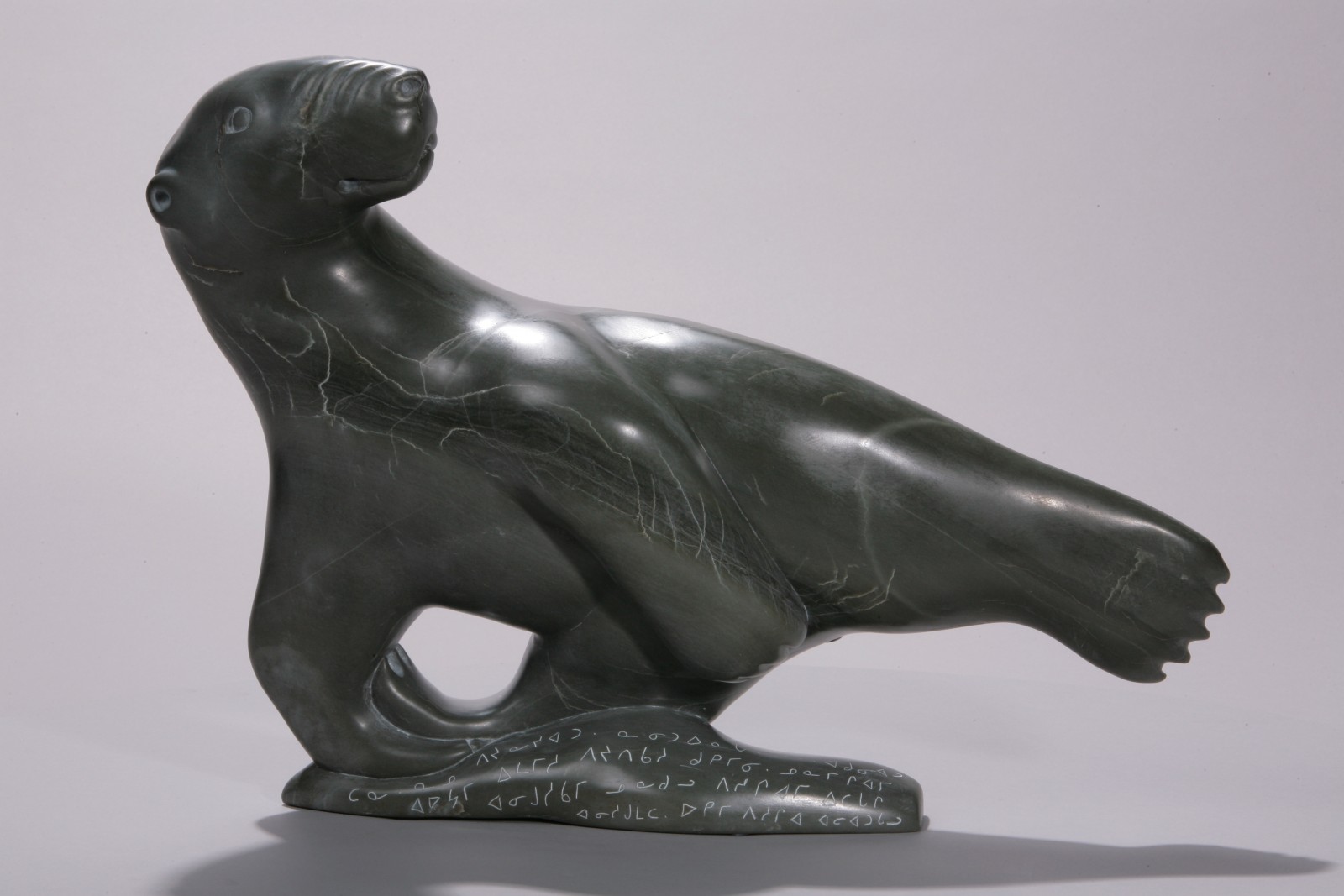
L’artiste a gravé en syllabiques (en inuktitut) directement sur la base de l’oeuvre ses commentaires personnels : « L’ours blanc a la capacité de survivre n’importe où. En été, il reste dans l’eau pendant de longues périodes parce que ses ongles le blessent lorsqu’il marche sur le sol. Il préfère marcher en hiver.
Cet ours blanc retourne sur le territoire après avoir séjourné longtemps dans l’eau. Il tourne la tête en remerciant le fait de pouvoir revenir à nouveau sur la terre ferme. » (Traduction libre)
In this work, the artist has engraved in syllabic (in inuktitut) his personal commentary directly on the base:
“the polar bear has the ability to survive no matter where he is. in summer, he remains in the water for long periods because his nails hurt when he walks on the land. he prefers walking in winter. this polar bear is returning to the land after a long time spent in the water. he turns his head and gives thanks to be able to go on firm ground again.” (free translation)
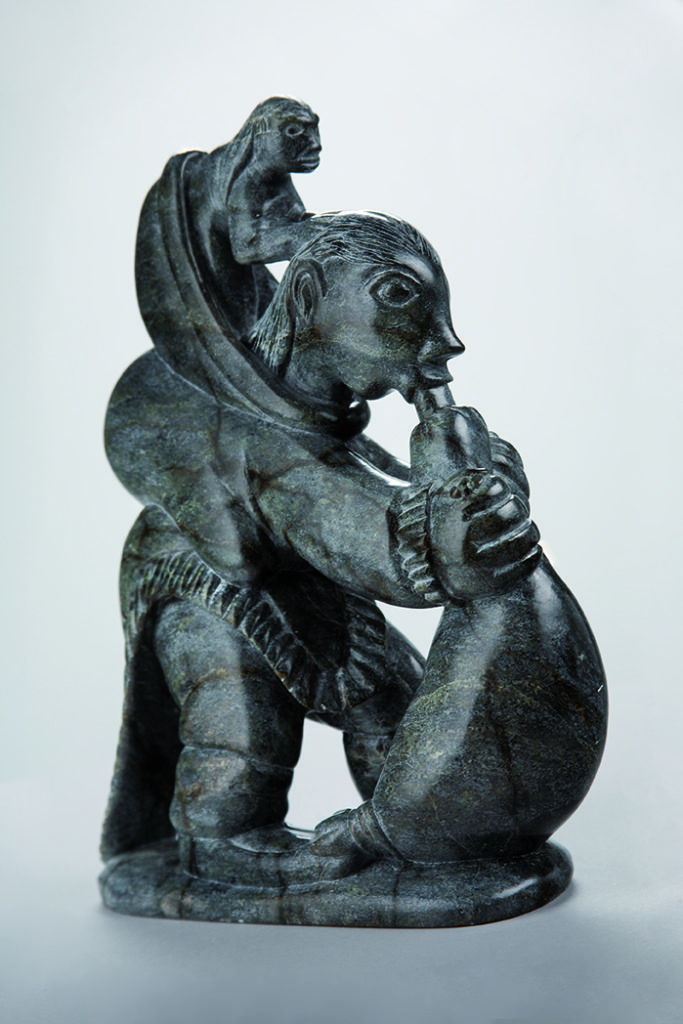
Cette femme porte son bébé sur son dos. Elle peut tout faire, même le travail d’un homme, car elle est très douée. Elle
construit un flotteur (avataq) en peau de phoque sur lequel elle va travailler dans quelques jours. Elle souffle de l’air dans l’avataqet elle va l’utiliser pour de grosses prises plus tard. Voici la signification de cette sculpture. Aussi, n’importe qui peut utiliser l’avataq, car il peut être utilisé pour plusieurs choses. Si vous me comprenez, merci.
This woman is carrying her baby son on her back. She can work on everything and anything, even a man’s job, because she is very capable. She is making a float (avataq) out of sealskin which she will work on in a few days. She is blowing air into the avataqas she will use it to catch bigger game later. That is what the carving means. Also, anybody can use an avataqas it can be used for many other purposes. If you understand, thank you.
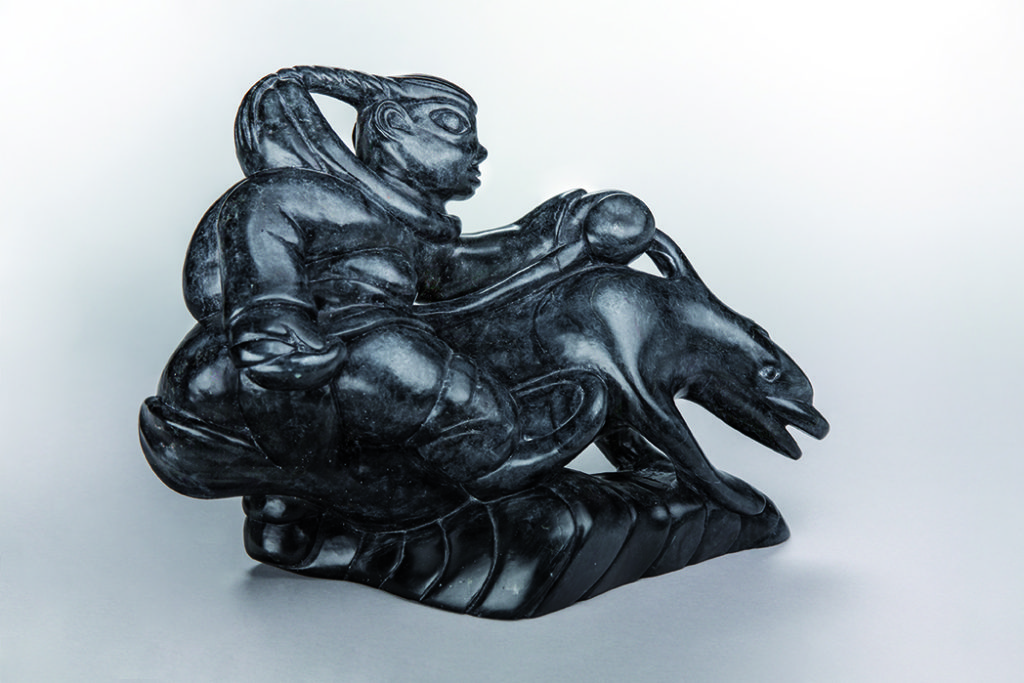
C’est une très vieille légende. C’est à propos d’une femme appelée Lumaaq et dans cette légende, son fils l’enroule à la taille dans une corde et l’attache à un béluga qui l’emporte. Donc, Lumaaq se met à suivre les bélugas qui sont restés bélugas pendant longtemps. Ils pouvaient être vus partout et se sont éventuellement fait appeler les Lumaaqs. C’est pour cette raison que cette femme se fait appeler Lumaaq. C’est ce que représente cette sculpture : une légende appelée Lumaaq.
This is a very old legend. It is about a woman called Lumaaq, where her son took a rope and tied her waist to a beluga and the whale dragged her away. So, Lumaaq ended up following belugas and they stayed belugas for a very long time. They would be seen everywhere and eventually got named the Lumaaqs. That is why this woman was named Lumaaq. That is what the carving represents: a legend called Lumaaq.
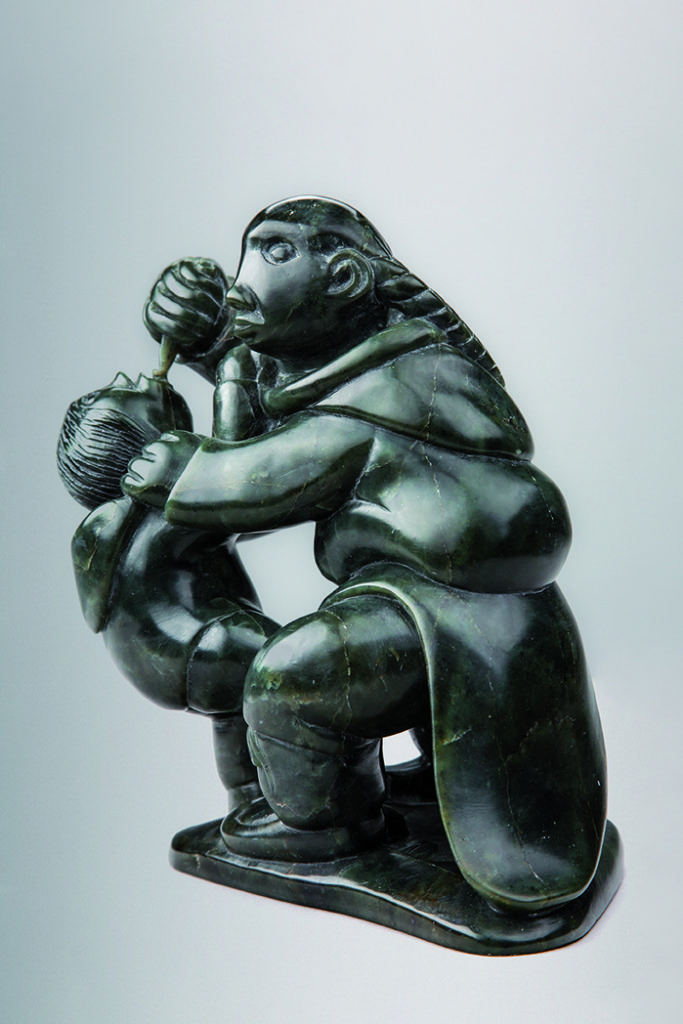
Cet homme et cette femme sont mariés. Et dans le temps, ça se passait comme ça. Quand quelqu’un avait mal aux dents, la dent était attachée à un fil de tendon et ensuite, arrachée. J’ai connu ça. Je pourrais moi-même arracher une dent branlante. Voici ce que ça signifie. Une fois la dent enlevée, la douleur s’en va. Ça peut se faire sans même l’aide d’une infirmière. C’est ce que cette sculpture signifie.
This man and woman are married. We were like that back then. When someone had a toothache, that tooth would be tied to a sinew thread and pulled out. Even I went through that, and I can even pull out someone’s bad tooth if it was loose. That is what it means. After the bad tooth has been pulled out, the pain goes away. That is what happens even if a nurse is not involved. That is what this carving means.
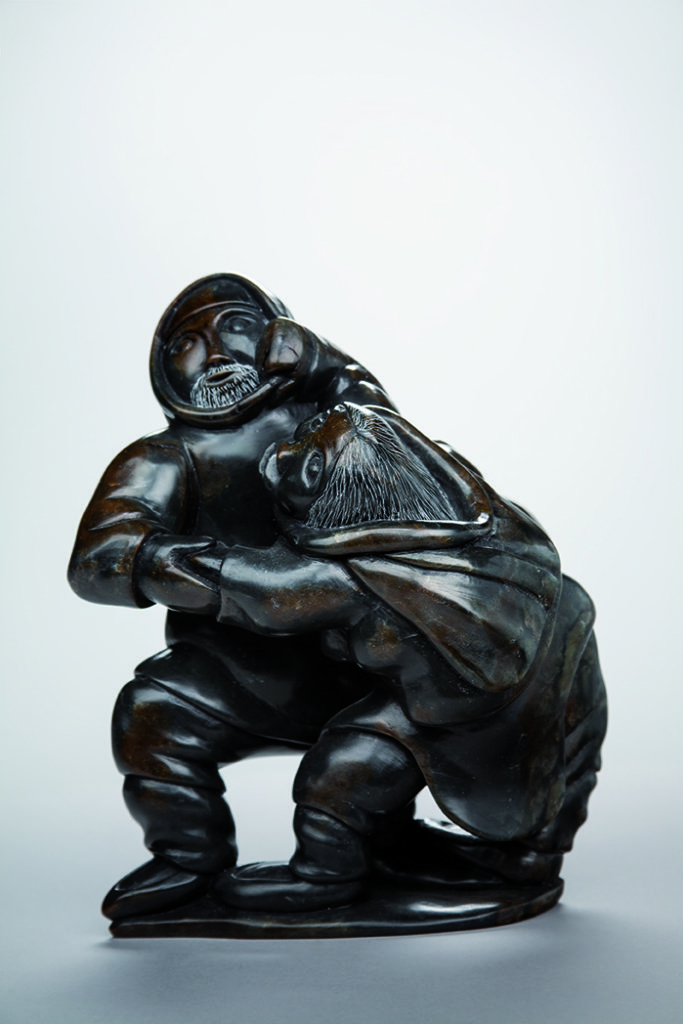
Voici un homme et une femme. L’histoire derrière cette sculpture est que l’homme veut marier cette belle femme, mais la femme le trouve repoussant, trop massif pour elle, trop gros, trop barbu. C’est ce que cette sculpture signifie.
Here is a man and a woman, and the story of the carving is: the man wants to wed this beautiful woman, but the woman finds him repulsive. He has too much beard and is too fat and looks too heavy for her. That is what the carving means.
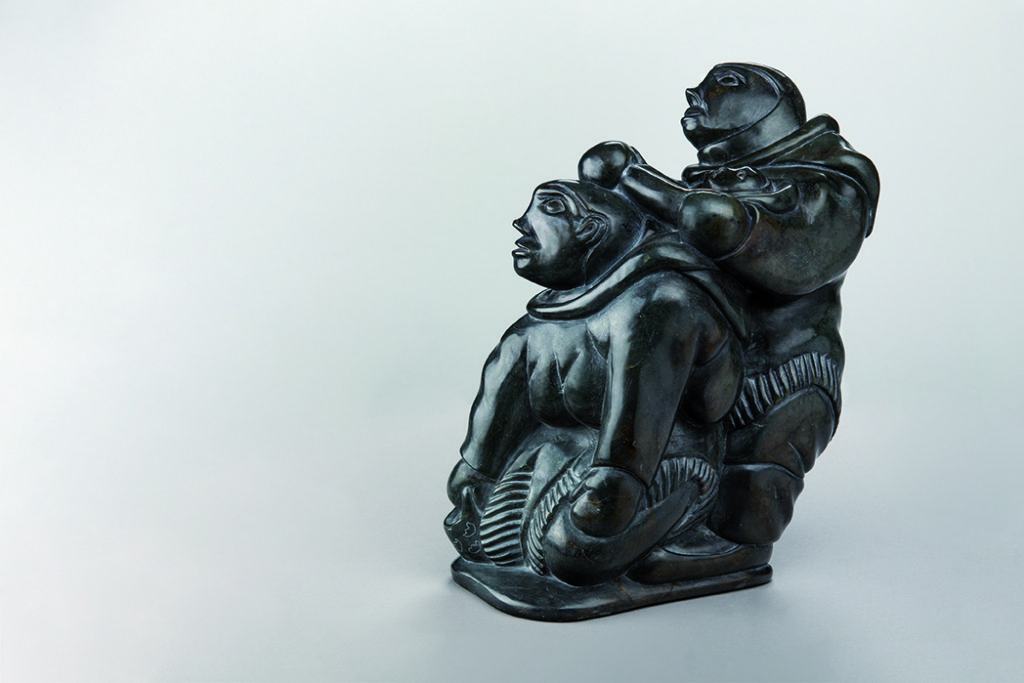
Cette famille marche pour aller chasser. Comme le garçon doit se soulager, les membres de cette famille doivent s’arrêter. Le père descend son fils des épaules de sa mère. La mère est en train de regarder un animal qu’elle ne peut pas identifier, car il est trop loin. Quand ils se remettront à marcher, ils iront en direction de l’animal. Voici la signification de la sculpture.
This family is walking to go hunting. Because the boy had to relieve himself, they had to stop on their journey. The father takes his son off his mother’s back. The mother is looking at an animal she can’t quite define since it is too far away. When they start walking again, they will head towards the animal. That is what the carving means.
Nunavik Art Alive
Inuit At Foundation
ᐊᓪᓚᑐᖅ | Texte de | Text by: Olivia Lya Thomassie
ᐊᑦᔨᓕᐊᕕᓂᕐᒥᓂᒃ ᐊᑐᕐᑕᐅᑎᑦᓯᓯᒪᔪᑦ / Crédits photos / Photos credits: Marie-Christine Couture